RESEARCHES研究領域
Focusing on the Architecture with ``Mathematical Modeling''
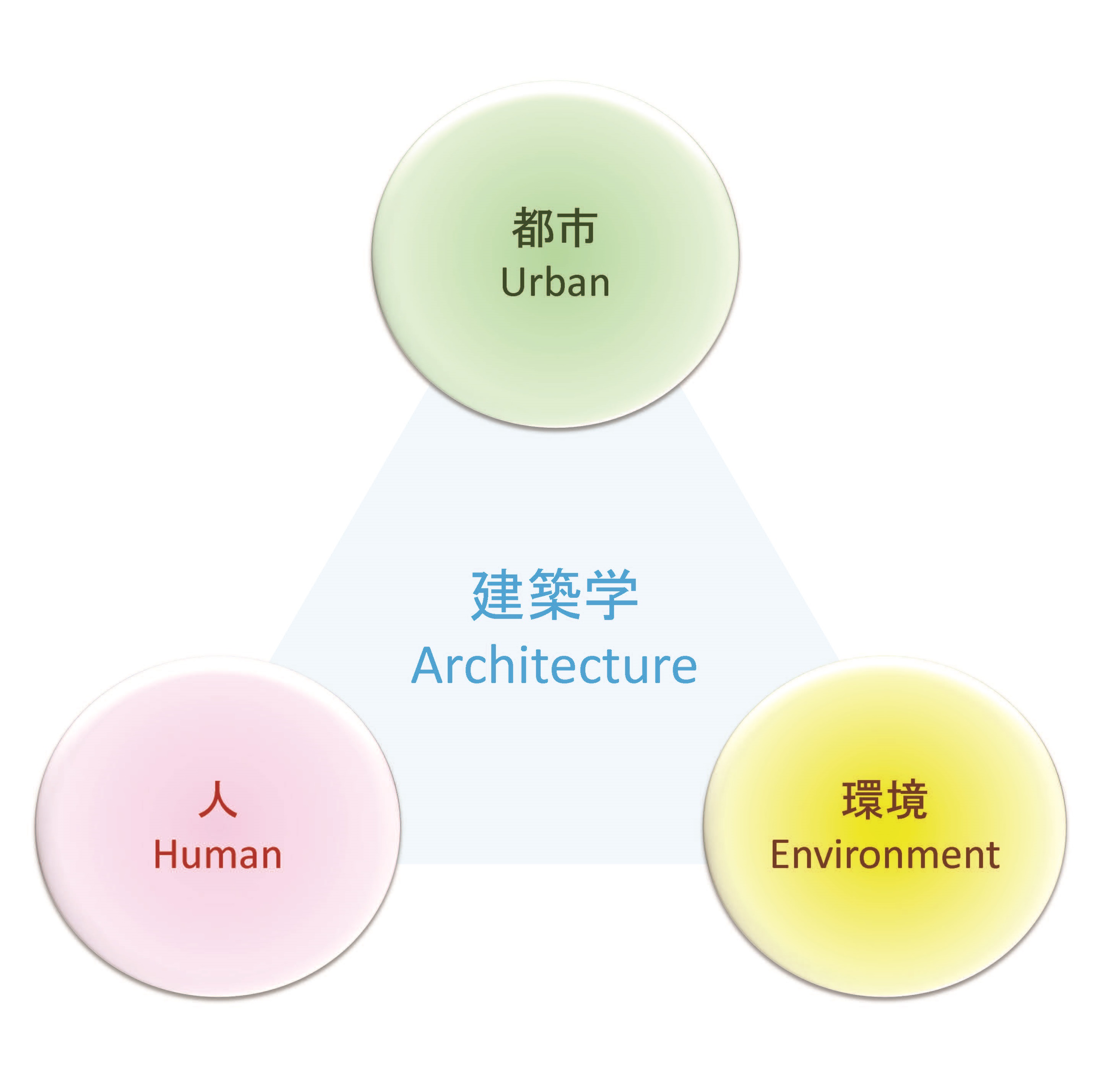 However, the excessive dependence on intuition and experience would make us deviate architectural planning from rationality of engineering.
In our laboratory, hence, mathematical methods for logical thinking, which helps us for decision of planning, are pursued.
Though, these might not be as attractive as designing,
planty of mathematical consequences will bring us the knowledge which is very effective tool for the planning.
However, the excessive dependence on intuition and experience would make us deviate architectural planning from rationality of engineering.
In our laboratory, hence, mathematical methods for logical thinking, which helps us for decision of planning, are pursued.
Though, these might not be as attractive as designing,
planty of mathematical consequences will bring us the knowledge which is very effective tool for the planning.
We must pay attention to social influence when tackling the architectural planing and designing. It is meaningful to incorporate several research fields adjacent to the architecture. From the standpoint stated above, in our laboratory, not only the architecture itself but also the interaction to ``Urban'', ``Human'' and ``Environment'' are deeply considered.
[Research Fields of Homma Lab.]
Analizing ``City and Architecture''
 The solid angle, which is closely related to the sky amount and sky factor, has been commonly used to assess
urban landscapes. In this research, we propose a new algorithm to calculate the solid angles of urban landscapes based
on computational geometry. This algorithm enables us to incorporate the complicated landscapes which consist of
multiple nonconvex polygons. Furthermore, using the algorithms, we assess the public space near Shibuya Station in
terms of solid angles. In the analysis, we describe how advertising billboards disturb our visibility. We also develop
the algorithm to calculate the sky amount and the sky factor, and evaluate both indexes.
The solid angle, which is closely related to the sky amount and sky factor, has been commonly used to assess
urban landscapes. In this research, we propose a new algorithm to calculate the solid angles of urban landscapes based
on computational geometry. This algorithm enables us to incorporate the complicated landscapes which consist of
multiple nonconvex polygons. Furthermore, using the algorithms, we assess the public space near Shibuya Station in
terms of solid angles. In the analysis, we describe how advertising billboards disturb our visibility. We also develop
the algorithm to calculate the sky amount and the sky factor, and evaluate both indexes.
[Sky factor for Shibuya Scramble Crossing]
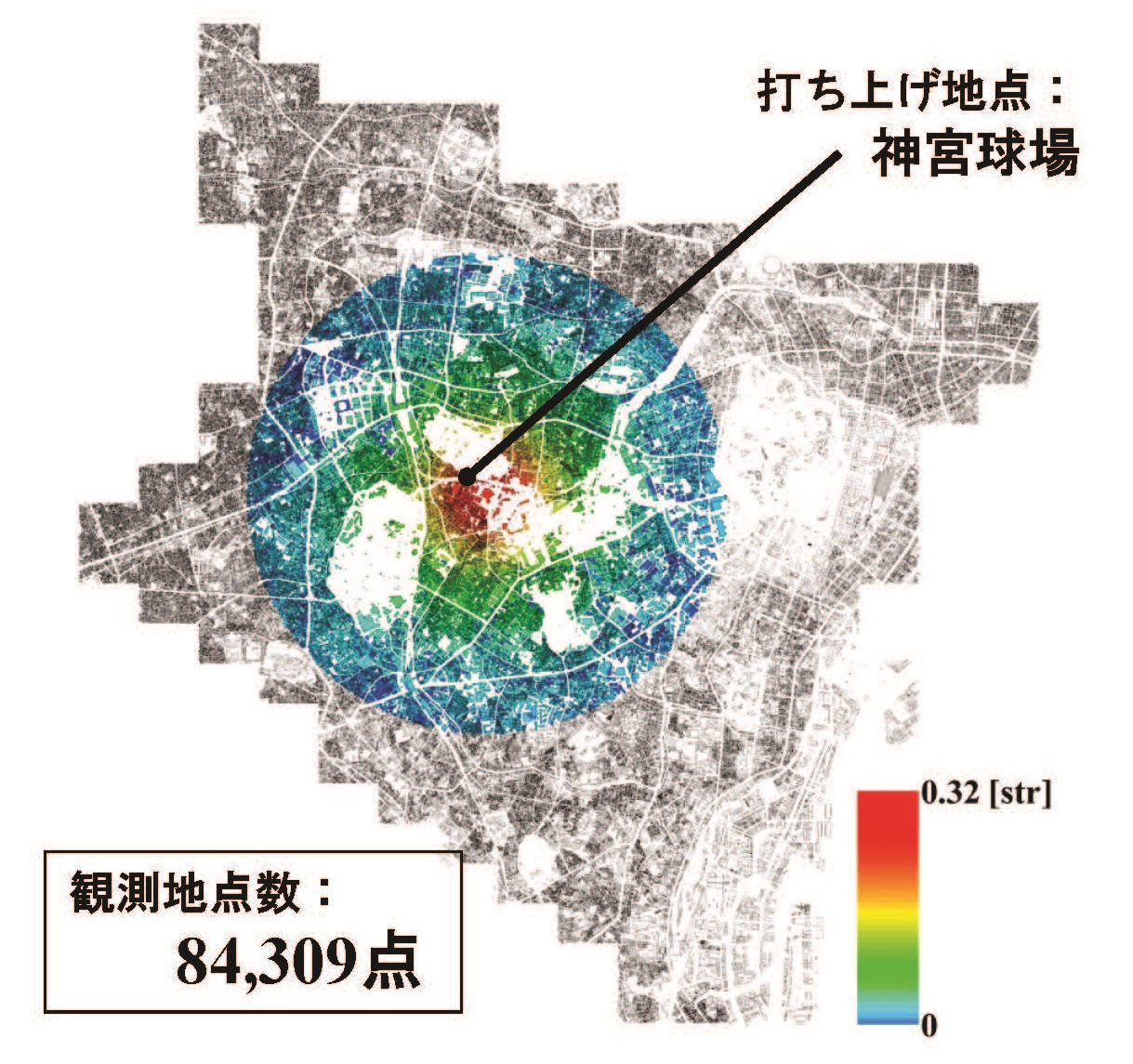 Fireworks displays are typical features of summer in Japan. Lots of Fireworks
festivals are held in everywhere, and people enjoy the art in the air.
However, in metropolitan area, there are so many buildings that fireworks
are often shielded by them. Searching the optimal view points which acquire
the full visibility is quite important.
In this research, we propose a mathematical model to evaluate the optimal
view points for fireworks displays. Using the scanning line vector methods,
we calculate the solid angles of actual fireworks displays with respect
to the shielding by millions of existing buildings in Tokyo metropolitan area.
Fireworks displays are typical features of summer in Japan. Lots of Fireworks
festivals are held in everywhere, and people enjoy the art in the air.
However, in metropolitan area, there are so many buildings that fireworks
are often shielded by them. Searching the optimal view points which acquire
the full visibility is quite important.
In this research, we propose a mathematical model to evaluate the optimal
view points for fireworks displays. Using the scanning line vector methods,
we calculate the solid angles of actual fireworks displays with respect
to the shielding by millions of existing buildings in Tokyo metropolitan area.
[Visibility Map of Fireworks]
Analizing ``Human''
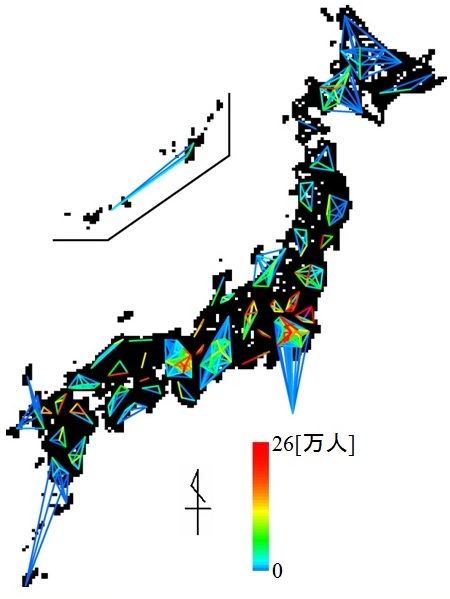 We are dynamically move everyday for commuting, attending school, shopping, and sightseeing, etc..
These movements are essential for sustainable and global society, and the concept of ``Trip-chaining behavior'' is also important.
Actually, we often enjoy vaious sightseeing spots at one travel behavior; this is an typical example.
We are dynamically move everyday for commuting, attending school, shopping, and sightseeing, etc..
These movements are essential for sustainable and global society, and the concept of ``Trip-chaining behavior'' is also important.
Actually, we often enjoy vaious sightseeing spots at one travel behavior; this is an typical example.
The Figure shown in the left indicates a result of such travel behaviors. More presicely, this model esimate the trip-chaining behavior ``in same prefecture'', which is very difficult to survey. Such results also enable us to calculate attractiveness and relation of various sightseeing spots.
[Estimation of Travel Behavior]
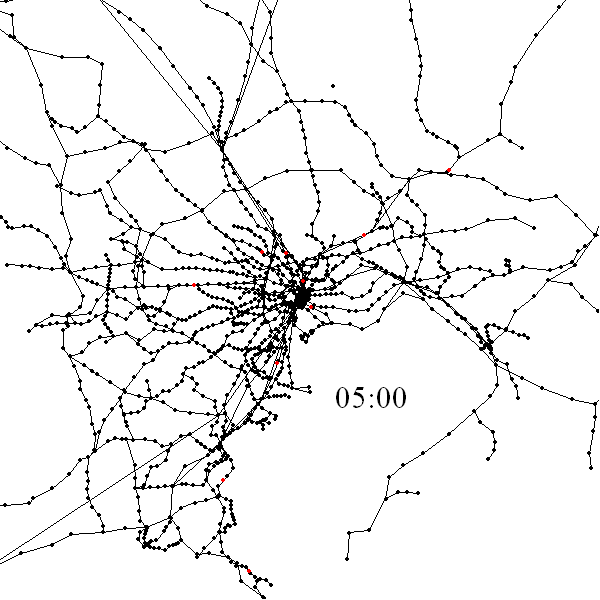 National census and Person-trip survey are the typical methods to enumerate the flow in soccial systems.
Though these surveys are quite famous and generally aculate, they are so expensive to conduct every year.
Hence ``estimating'' the flow is very important and meaningfull.
National census and Person-trip survey are the typical methods to enumerate the flow in soccial systems.
Though these surveys are quite famous and generally aculate, they are so expensive to conduct every year.
Hence ``estimating'' the flow is very important and meaningfull.
The series of such studies are called ``spatial interaction model'', and our laboratory tris to generalize the model from a point of ``trip-chaining type flow''. Our theory can adopt not only human behavior but also various systems, such as IP routing protocols and Hierarchical logistics.
[Visualization of Commuting Flow in Tokyo]
For Detail -> (Refereed Journal Articles)
Analyzing ‘’Environment’’
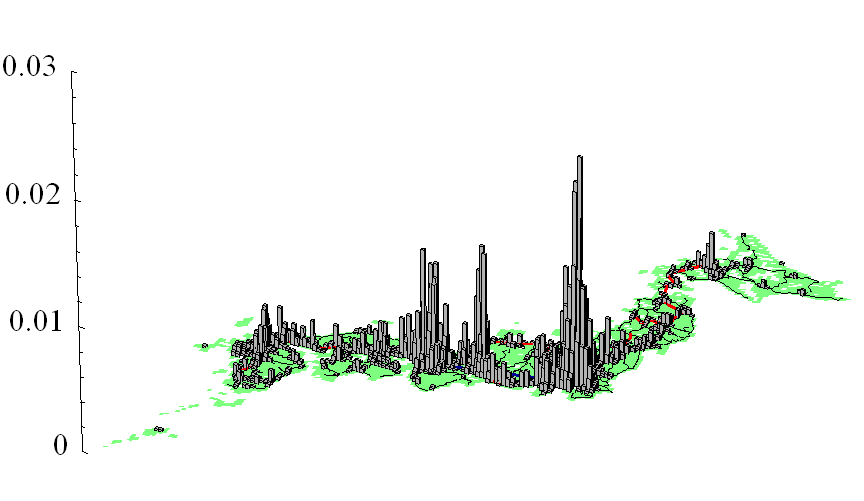 As properties of balancing-mechanism, it is known that the derived distribution depends on the various
elements such as the shape of region or transportation network. In this research, we take the balancing-mechanism
in the general urban activities, and analyze the dynamics of urban activity distribution with respect to the advance
of high-speed transit system. In particular, focusing on the Japanese railway system, we examine how the
construction of Shinkansen bullet train affects the developments of cities in Japan. As a result, we clarified
that the opening of high-speed transit system promotes the further developments of large cities, and miserable
declinations of small cities.
As properties of balancing-mechanism, it is known that the derived distribution depends on the various
elements such as the shape of region or transportation network. In this research, we take the balancing-mechanism
in the general urban activities, and analyze the dynamics of urban activity distribution with respect to the advance
of high-speed transit system. In particular, focusing on the Japanese railway system, we examine how the
construction of Shinkansen bullet train affects the developments of cities in Japan. As a result, we clarified
that the opening of high-speed transit system promotes the further developments of large cities, and miserable
declinations of small cities.
[Urban Dynamics by Transit Systems]
For Detail -> (Refereed Journal Articles)
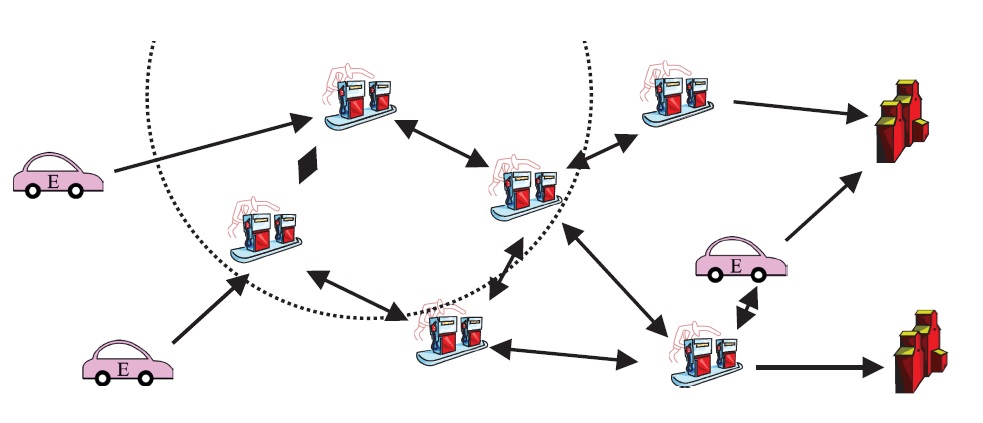 which may lead to a call-loss condition.
In other words, an appropriate number of chargers must be installed at
each station when planning the EV infrastructure. Therefore, the number of vehicles entering the station must be estimated. In this study, a
mathematical model based on the supporting infrastructure for widespread EV use is proposed to estimate the number of vehicles arriving at
each charge station.
which may lead to a call-loss condition.
In other words, an appropriate number of chargers must be installed at
each station when planning the EV infrastructure. Therefore, the number of vehicles entering the station must be estimated. In this study, a
mathematical model based on the supporting infrastructure for widespread EV use is proposed to estimate the number of vehicles arriving at
each charge station.
[Example of EV Routing Network]
For Detail -> (Refereed Journal Articles)
``Architecture'' as Interface
When designing the architectures, it goes without saying that intuition and experienc are quite important. However, the excessive dependence on intuition and experience would make us deviate architectural planning from rationality of engineering.
In our laboratory, hence, mathematical methods for logical thinking, which helps us for decision of planning, are pursued.
Though, these might not be as attractive as designing,
planty of mathematical consequences will bring us the knowledge which is very effective tool for the planning.
However, the excessive dependence on intuition and experience would make us deviate architectural planning from rationality of engineering.
In our laboratory, hence, mathematical methods for logical thinking, which helps us for decision of planning, are pursued.
Though, these might not be as attractive as designing,
planty of mathematical consequences will bring us the knowledge which is very effective tool for the planning. We must pay attention to social influence when tackling the architectural planing and designing. It is meaningful to incorporate several research fields adjacent to the architecture. From the standpoint stated above, in our laboratory, not only the architecture itself but also the interaction to ``Urban'', ``Human'' and ``Environment'' are deeply considered.
[Research Fields of Homma Lab.]
Analizing ``City and Architecture''
New Algorithm to Calculate the Sky Factor
 The solid angle, which is closely related to the sky amount and sky factor, has been commonly used to assess
urban landscapes. In this research, we propose a new algorithm to calculate the solid angles of urban landscapes based
on computational geometry. This algorithm enables us to incorporate the complicated landscapes which consist of
multiple nonconvex polygons. Furthermore, using the algorithms, we assess the public space near Shibuya Station in
terms of solid angles. In the analysis, we describe how advertising billboards disturb our visibility. We also develop
the algorithm to calculate the sky amount and the sky factor, and evaluate both indexes.
The solid angle, which is closely related to the sky amount and sky factor, has been commonly used to assess
urban landscapes. In this research, we propose a new algorithm to calculate the solid angles of urban landscapes based
on computational geometry. This algorithm enables us to incorporate the complicated landscapes which consist of
multiple nonconvex polygons. Furthermore, using the algorithms, we assess the public space near Shibuya Station in
terms of solid angles. In the analysis, we describe how advertising billboards disturb our visibility. We also develop
the algorithm to calculate the sky amount and the sky factor, and evaluate both indexes.[Sky factor for Shibuya Scramble Crossing]
Optimal View Points for FireworksDisplays Using Big Size Building Polygon Data
 Fireworks displays are typical features of summer in Japan. Lots of Fireworks
festivals are held in everywhere, and people enjoy the art in the air.
However, in metropolitan area, there are so many buildings that fireworks
are often shielded by them. Searching the optimal view points which acquire
the full visibility is quite important.
In this research, we propose a mathematical model to evaluate the optimal
view points for fireworks displays. Using the scanning line vector methods,
we calculate the solid angles of actual fireworks displays with respect
to the shielding by millions of existing buildings in Tokyo metropolitan area.
Fireworks displays are typical features of summer in Japan. Lots of Fireworks
festivals are held in everywhere, and people enjoy the art in the air.
However, in metropolitan area, there are so many buildings that fireworks
are often shielded by them. Searching the optimal view points which acquire
the full visibility is quite important.
In this research, we propose a mathematical model to evaluate the optimal
view points for fireworks displays. Using the scanning line vector methods,
we calculate the solid angles of actual fireworks displays with respect
to the shielding by millions of existing buildings in Tokyo metropolitan area.[Visibility Map of Fireworks]
Analizing ``Human''
Estimation of the Citizon's Movements in Terms of Trip-chaining Behavior
 We are dynamically move everyday for commuting, attending school, shopping, and sightseeing, etc..
These movements are essential for sustainable and global society, and the concept of ``Trip-chaining behavior'' is also important.
Actually, we often enjoy vaious sightseeing spots at one travel behavior; this is an typical example.
We are dynamically move everyday for commuting, attending school, shopping, and sightseeing, etc..
These movements are essential for sustainable and global society, and the concept of ``Trip-chaining behavior'' is also important.
Actually, we often enjoy vaious sightseeing spots at one travel behavior; this is an typical example.The Figure shown in the left indicates a result of such travel behaviors. More presicely, this model esimate the trip-chaining behavior ``in same prefecture'', which is very difficult to survey. Such results also enable us to calculate attractiveness and relation of various sightseeing spots.
[Estimation of Travel Behavior]
Spatial Interaction Theory for Trip-chaining Type Flow
 National census and Person-trip survey are the typical methods to enumerate the flow in soccial systems.
Though these surveys are quite famous and generally aculate, they are so expensive to conduct every year.
Hence ``estimating'' the flow is very important and meaningfull.
National census and Person-trip survey are the typical methods to enumerate the flow in soccial systems.
Though these surveys are quite famous and generally aculate, they are so expensive to conduct every year.
Hence ``estimating'' the flow is very important and meaningfull. The series of such studies are called ``spatial interaction model'', and our laboratory tris to generalize the model from a point of ``trip-chaining type flow''. Our theory can adopt not only human behavior but also various systems, such as IP routing protocols and Hierarchical logistics.
[Visualization of Commuting Flow in Tokyo]
For Detail -> (Refereed Journal Articles)
Analyzing ‘’Environment’’
The Urban Dynamics Focusing on the Advance of High-Speed Transit Systems
The dynamics of commercial activities in cities has been explored by the Harris-Wilson’s balancing-mechanism model. As properties of balancing-mechanism, it is known that the derived distribution depends on the various
elements such as the shape of region or transportation network. In this research, we take the balancing-mechanism
in the general urban activities, and analyze the dynamics of urban activity distribution with respect to the advance
of high-speed transit system. In particular, focusing on the Japanese railway system, we examine how the
construction of Shinkansen bullet train affects the developments of cities in Japan. As a result, we clarified
that the opening of high-speed transit system promotes the further developments of large cities, and miserable
declinations of small cities.
As properties of balancing-mechanism, it is known that the derived distribution depends on the various
elements such as the shape of region or transportation network. In this research, we take the balancing-mechanism
in the general urban activities, and analyze the dynamics of urban activity distribution with respect to the advance
of high-speed transit system. In particular, focusing on the Japanese railway system, we examine how the
construction of Shinkansen bullet train affects the developments of cities in Japan. As a result, we clarified
that the opening of high-speed transit system promotes the further developments of large cities, and miserable
declinations of small cities.[Urban Dynamics by Transit Systems]
For Detail -> (Refereed Journal Articles)
Analysis of Support Infrastructure for Electric Vehicles
As environmental issues become more prominent, electric vehicles (EV) have attracted an increasing amount of attention. However, the continuous cruising distance of an EV is limited to approximately 160 km, which is insufficient for everyday use. Battery capacity is the limiting factor in long-distance EV travel, because the vehicles need to stop at EV recharging stations multiple times. In Japan, there are more than 2,000 EV charge stations, but there are, at most, two rapid chargers. When multiple users converge at the station, a queuing (or waiting) condition is created, which may lead to a call-loss condition.
In other words, an appropriate number of chargers must be installed at
each station when planning the EV infrastructure. Therefore, the number of vehicles entering the station must be estimated. In this study, a
mathematical model based on the supporting infrastructure for widespread EV use is proposed to estimate the number of vehicles arriving at
each charge station.
which may lead to a call-loss condition.
In other words, an appropriate number of chargers must be installed at
each station when planning the EV infrastructure. Therefore, the number of vehicles entering the station must be estimated. In this study, a
mathematical model based on the supporting infrastructure for widespread EV use is proposed to estimate the number of vehicles arriving at
each charge station.[Example of EV Routing Network]
For Detail -> (Refereed Journal Articles)
HONMA LABORATORY
The University of Tokyo
Institute of Industrial Science
4-6-1, Komaba, Meguro-ku, Tokyo, 153-8505, JAPAN